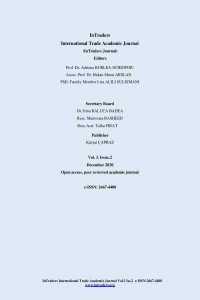The Innovation Development of the European Union: Regional Clustering
Anahtar Kelimeler:
regional innovation development, regional clustering, the European Union, global and local Moran I
The Innovation Development of the European Union: Regional Clustering
Innovative development is one of the political priorities of the European Union countries. The Commission of the European Communities recommends that countries pursue innovation policies at the regional level. The regional development of innovations is possible only in conditions of openness. It is important to understand in which conditions the regions will support each other, and in which they will become competitors pulling over limited resources.
The strength of mutual influence is determined by economic, technological and geographical distances. In this paper the goal is to understand how patent activity in one region effects the number of patents of other neighboring territories in the European Union regions. The research methodology of this study consists of the calculation of spatial autocorrelation (global and local Moran index I) by the number of patents in 2018-2021 in 169 regions of Europe.
Among the regions four groups were identified: innovation cluster centers, innovation agglomerations, the neighbors of innovative cores and the territories outside the influence. The dynamics of development is also analyzed. Among the results, it is shown that most regions of the EU regions have the low level of patent activity. However, in some cases regions form technological clusters (in Germany, Belgium, the Netherlands) or pull assets from neighbors to more innovative regions (in France, Austria, Denmark). Moreover, it is obtained that there are potential innovation centers such as Castile-Leon (Spain), Masovian voivodeship (Poland). Understanding the emerging innovation blocs in the European Union will allow to implement more focused and effective policy.
Keywords:
regional innovation development, regional clustering, the European Union, global and local Moran I,
___
- Audretsch, D. B., & Feldman, M. P. (1996). R&D Spillovers and The Geography of Innovation and Production. The American economic review, 86(3), 630-640.
- Auty, R. M. (2005). Natural Resource Rent‐cycling Outcomes in Botswana, Indonesia and Venezuela. International Social Science Journal, 57, 33-44.
- Baldwin, R. E., & Martin, P. (2004). Agglomeration and Regional Growth. Handbook of regional and urban economics, 4(3960), 2671-2711.
- Chen, J., Wang, L., & Li, Y. (2020). Natural Resources, Urbanization and Regional Innovation Capabilities. Resources Policy, 66, 101643.
- Deloitte. (2020). Survey of Global Investment and Innovation Incentives. https://www2.deloitte.com/global/en/pages/tax/articles/global-investment-and-innovation-incentives-survey.html
- Fujita, M., Krugman, P., & Mori, T. (1999). On the Evolution of Hierarchical Urban Systems. European Economic Review, 43(2), 209-251.
- Kolesnikova, I. (2012). The Problems of Development of National Innovation System. Nierówności społeczne a wzrost gospodarczy, 26, 107-121.
- Krugman, P. (1991). Increasing Return and Economic Geography. Journal of Political Economy, 99(3), 483-499.
- Leijten, J. (2019). Innovation Policy and International Relations: Directions for EU Diplomacy. European Journal of Futures Research, 7(1), 4.
- Moreno R., Paci R., & Usai S. (2005). Geographical and Sectoral Clusters of Innovation in Europe. The Annals of Regional Science, 39(4), 715-739.
- Nooteboom, B. (2007). Social Capital, Institutions and Trust. Review of social economy, 65(1), 29-53. OECD Data (2022). Gross Domestic Spending on R&D. https://data.oecd.org/rd/gross-domestic-spending-on-r-d.htm
- OECD iLibrary (2021). OECD Science, Technology and Innovation Outlook 202: Times of Crisis and Opportunity. https://www.oecd-ilibrary.org/sites/7a7891a5-en/index.html?itemId=/content/component/7a7891a5-en#section-d1e7842
- Paci, R., & Usai, S. (1999) Externalities, Knowledge Spillovers and the Spatial Distribution of Innovation. GeoJournal, 4, 381-390.
- Papyrakis, E., & Gerlagh, R. (2007). Resource Abundance and Economic Growth in the United States. European Economic Review, 51(4), 1011-1039.
- Patrusheva E.G., & Pajhlina A.V. (2021). Clustering as a Competitive Advantage of Regional Economics. Journal of Regional and International Competitiveness, 3(2), 33-41.
- Pavlov Yu. V., Koroleva E. N (2014). Spatial Interactions: Assessment Based on Global and Local Moran indices. Spatial Economics, 3, 95-110.
- Rosario, C., Costa, A. A., & da Silva, A. L. (2019). The Impact of Information and Communication Technologies on Countries Economic Growth. Economic and Social Development: Book of Proceedings. Lisbon: Ana L. da Silva, Daniel Tomic, Alica Grilec.
- Rosenthal, S. S., & Strange, W. C. (2004). Evidence on the nature and sources of agglomeration economies. Handbook of regional and urban economics, 4, 2119-2171.
- Wang, H.X., Sun, F., 2009. Analysis on the dynamic mechanism of regional innovation system. China. Sci. Technol. Forum 1, 36–40. Цит. по: Chen, J., Wang, L., & Li, Y. (2020). Natural resources, urbanization and regional innovation capabilities. Resources Policy, 66, 101643.
- Zhang, P., & He, L. (2017). Government Intervention, Resource Curse and Regional Innovation: Evidence from Mainland China. Science Research Management, 38(1), 62-69.
- Yayın Aralığı: Yılda 2 Sayı
- Başlangıç: 2018
- Yayıncı: Kürşat ÇAPRAZ
Sayıdaki Diğer Makaleler
The Innovation Development of the European Union: Regional Clustering
Uluslararası Vergileme İş Birliğinde Güncel Eğilimler
Uçak Etkinliğinin Operasyonel ve Finansal Metrikler Açısından Analitik Olarak İncelenmesi
The Competitiveness Position of The Republic of North Macedonia: Opportunities And Weaknesses
Kristina VELİCHKOVSKA, Nehat RAMADANİ
Andrijana BOJADJİEVSKA DANEVSKA
María Jesús ARROYO FERNÁNDEZ, Pedro FERNÁNDEZ SÁNCHEZ, María-carmen GARCÍA-CENTENO, Inmaculada HURTADO OCAÑA
